1、SpringMVC简介
1.1、什么是MVC
MVC是一种软件架构的思想,将软件按照模型、视图、控制器来划分
M:Model,模型层,指工程中的JavaBean,作用是处理数据
JavaBean分为两类:
V:View,视图层,指工程中的html或jsp等页面,作用是与用户进行交互,展示数据
C:Controller,控制层,指工程中的servlet,作用是接收请求和响应浏览器
MVC的工作流程: 用户通过视图层发送请求到服务器,在服务器中请求被Controller接收,Controller
调用相应的Model层处理请求,处理完毕将结果返回到Controller,Controller再根据请求处理的结果
找到相应的View视图,渲染数据后最终响应给浏览器
1.2、什么是SpringMVC
SpringMVC是Spring的一个后续产品,是Spring的一个子项目
SpringMVC 是 Spring 为表述层开发提供的一整套完备的解决方案。在表述层框架历经 Strust、
WebWork、Strust2 等诸多产品的历代更迭之后,目前业界普遍选择了 SpringMVC 作为 Java EE 项目
表述层开发的首选方案。
注:三层架构分为表述层(或表示层)、业务逻辑层、数据访问层,表述层表示前台页面和后台
servlet
1.3、SpringMVC的特点
处理
2.2、创建maven工程
①添加web模块
②打包方式:war
③引入依赖
<dependencies>
<!-- SpringMVC -->
<dependency>
<groupId>org.springframework</groupId>
<artifactId>spring-webmvc</artifactId>
<version>5.3.1</version>
</dependency>
<!-- 日志 -->
<dependency>
<groupId>ch.qos.logback</groupId>
<artifactId>logback-classic</artifactId>
<version>1.2.3</version>
</dependency>
<!-- ServletAPI -->
<dependency>
<groupId>javax.servlet</groupId>
<artifactId>javax.servlet-api</artifactId>
<version>3.1.0</version>
<scope>provided</scope>
</dependency>
<!-- Spring5和Thymeleaf整合包 -->
<dependency>
<groupId>org.thymeleaf</groupId>
<artifactId>thymeleaf-spring5</artifactId>
<version>3.0.12.RELEASE</version>
</dependency>
</dependencies>
注:由于 Maven 的传递性,我们不必将所有需要的包全部配置依赖,而是配置最顶端的依赖,其他靠
传递性导入。
2.3、配置web.xml
注册SpringMVC的前端控制器DispatcherServlet
①默认配置方式
此配置作用下,SpringMVC的配置文件默认位于WEB-INF下,默认名称为-
servlet.xml,例如,以下配置所对应SpringMVC的配置文件位于WEB-INF下,文件名为springMVC-
servlet.xml
<!-- 配置SpringMVC的前端控制器,对浏览器发送的请求统一进行处理 -->
<servlet>
<servlet-name>springMVC</servlet-name>
<servlet-class>org.springframework.web.servlet.DispatcherServlet</servletclass>
</servlet>
<servlet-mapping>
<servlet-name>springMVC</servlet-name>
<!--
设置springMVC的核心控制器所能处理的请求的请求路径
/所匹配的请求可以是/login或.html或.js或.css方式的请求路径
但是/不能匹配.jsp请求路径的请求,因为.DispatcherServlet不能处理jsp的请求
/* 会匹配全部
-->
<url-pattern>/</url-pattern>
</servlet-mapping>
②扩展配置方式
可通过init-param标签设置SpringMVC配置文件的位置和名称,通过load-on-startup标签设置
SpringMVC前端控制器DispatcherServlet的初始化时间==(原本是第一次访问的时候初始化)==
<!-- 配置SpringMVC的前端控制器,对浏览器发送的请求统一进行处理 -->
<servlet>
<servlet-name>springMVC</servlet-name>
<servlet-class>org.springframework.web.servlet.DispatcherServlet</servletclass>
<!-- 通过初始化参数指定SpringMVC配置文件的位置和名称 -->
<init-param>
<!-- contextConfigLocation为固定值 -->
<param-name>contextConfigLocation</param-name>
<!-- 使用classpath:表示从类路径查找配置文件,例如maven工程中的src/main/resources -->
<param-value>classpath:springMVC.xml</param-value>
</init-param>
<!--
作为框架的核心组件,在启动过程中有大量的初始化操作要做
而这些操作放在第一次请求时才执行会严重影响访问速度
因此需要通过此标签将启动控制DispatcherServlet的初始化时间提前到服务器启动时
-->
<load-on-startup>1</load-on-startup>
</servlet>
<servlet-mapping>
<servlet-name>springMVC</servlet-name>
<!--
设置springMVC的核心控制器所能处理的请求的请求路径
/所匹配的请求可以是/login或.html或.js或.css方式的请求路径
但是/不能匹配.jsp请求路径的请求
-->
<url-pattern>/</url-pattern>
</servlet-mapping>
注:
标签中使用/和/*的区别:
/所匹配的请求可以是/login或.html或.js或.css方式的请求路径,但是/不能匹配.jsp请求路径的请
求
jsp的请求是用tomcat里面配置的jsp-Servlet处理的
因此就可以避免在访问jsp页面时,该请求被DispatcherServlet处理,从而找不到相应的页面
/*则能够匹配所有请求,例如在使用过滤器时,若需要对所有请求进行过滤,就需要使用/*的写
法
2.4、创建请求控制器
由于前端控制器对浏览器发送的请求进行了统一的处理,但是具体的请求有不同的处理过程,因此需要创建处理具体请求的类,即请求控制器
请求控制器中每一个处理请求的方法成为控制器方法
因为SpringMVC的控制器由一个POJO(普通的Java类)担任,因此需要通过@Controller注解将其标识为一个控制层组件,交给Spring的IoC容器管理,此时SpringMVC才能够识别控制器的存在
@Controller
public class HelloController {
}
2.5、创建SpringMVC的配置文件
[!note]
把前缀去掉,后缀去掉就是逻辑视图,比如templates文件夹下index.html的访问只要输入index即可
<!-- 自动扫描包 -->
<context:component-scan base-package="com.atguigu.mvc.controller"/>
<!-- 配置Thymeleaf视图解析器 -->
<bean id="viewResolver"class="org.thymeleaf.spring5.view.ThymeleafViewResolver">
<property name="order" value="1"/>
<property name="characterEncoding" value="UTF-8"/>
<property name="templateEngine">
<bean class="org.thymeleaf.spring5.SpringTemplateEngine">
<property name="templateResolver">
<bean
class="org.thymeleaf.spring5.templateresolver.SpringResourceTemplateResolver">
<!-- 视图前缀 -->
<property name="prefix" value="/WEB-INF/templates/"/>
<!-- 视图后缀 -->
<property name="suffix" value=".html"/>
//模板的模型是html5
<property name="templateMode" value="HTML5"/>
<property name="characterEncoding" value="UTF-8" />
</bean>
</property>
</bean>
</property>
</bean>
<!--
处理静态资源,例如html、js、css、jpg
若只设置该标签,则只能访问静态资源,其他请求则无法访问
此时必须设置<mvc:annotation-driven/>解决问题
-->
<mvc:default-servlet-handler/>
<!-- 开启mvc注解驱动 -->
<mvc:annotation-driven>
<mvc:message-converters>
<!-- 处理响应中文内容乱码 -->
<bean
class="org.springframework.http.converter.StringHttpMessageConverter">
<property name="defaultCharset" value="UTF-8" />
<property name="supportedMediaTypes">
<list>
<value>text/html</value>
<value>application/json</value>
</list>
</property>
</bean>
</mvc:message-converters>
</mvc:annotation-driven>
2.6 .配置本地Tomcat
1.选择本地Tomcat
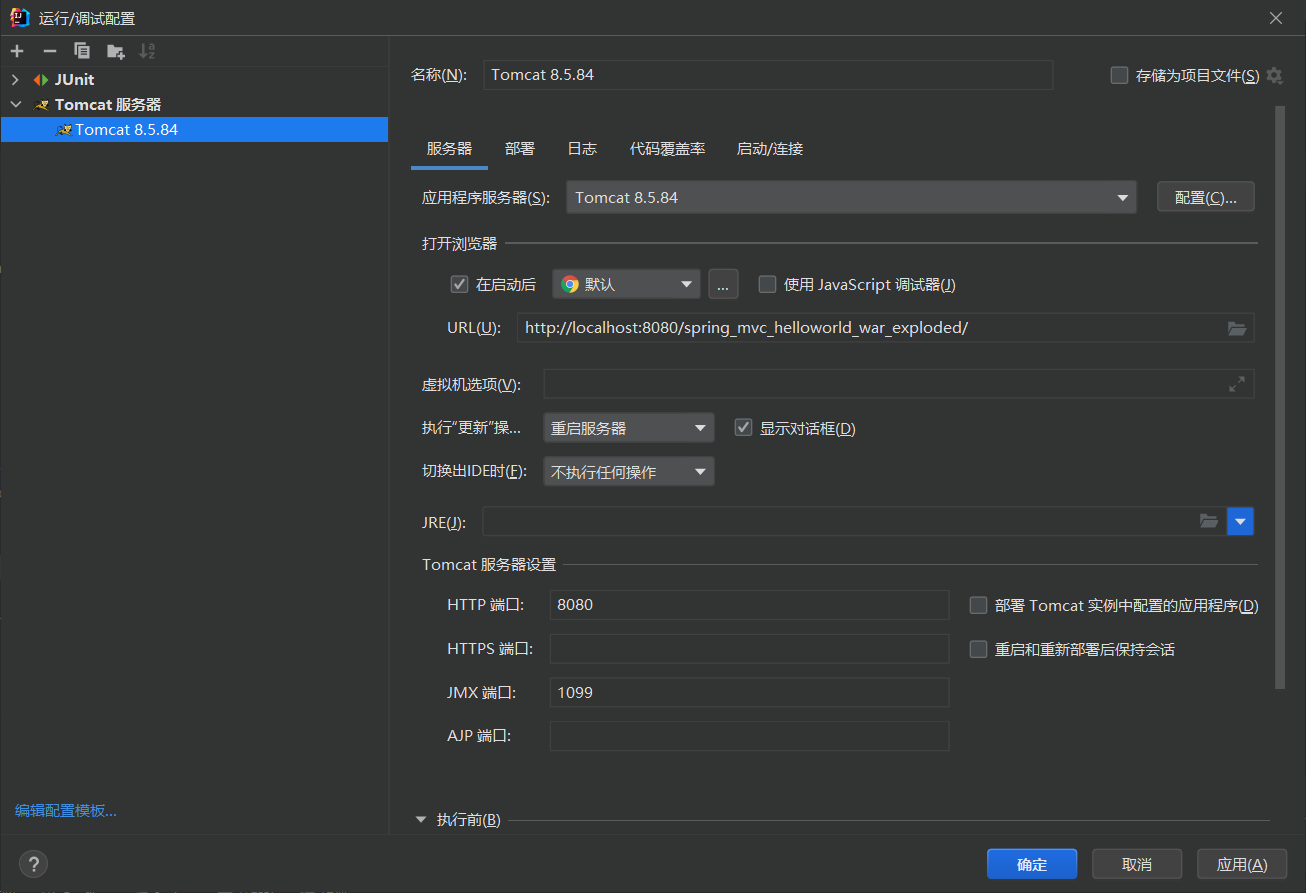
选择
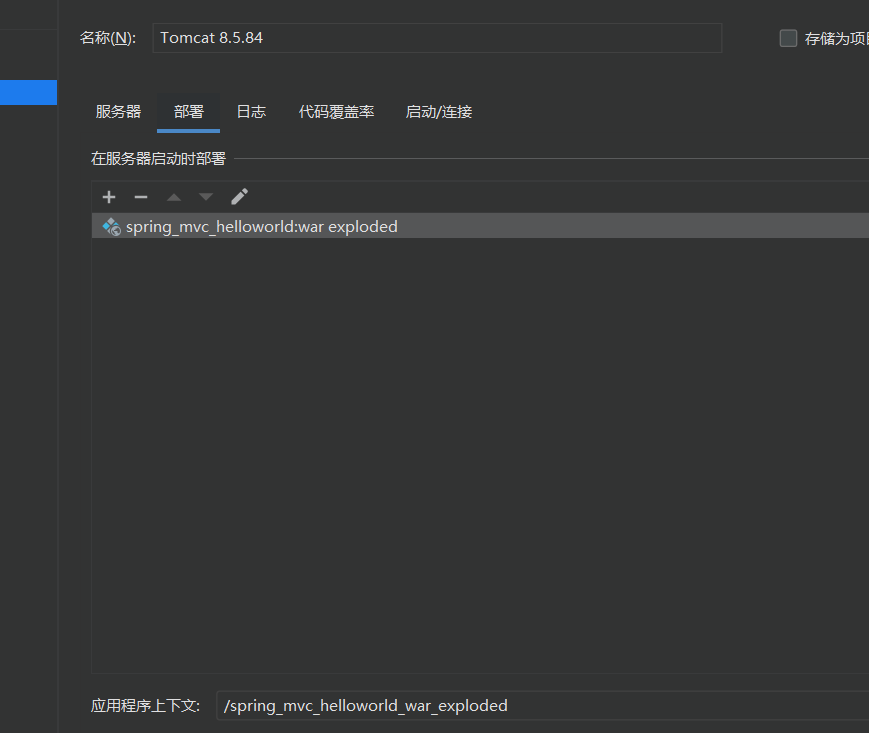
配置上下文路径,通过这个就可以访问工程了
[外链图片转存失败,源站可能有防盗链机制,建议将图片保存下来直接上传(img-JN0YlHm3-1686124823354)(null)]
设置更新按钮和失去焦点事件

2.7、测试HelloWorld
①实现对首页的访问
本身是访问不到WEB-INF下面的内容的,只能通过转发的方式来访问
在请求控制器中创建处理请求的方法
RequestMapping就是请求映射的意思, * 就是把浏览器的请求映射为这个方法,这个方法就是解决请求的,RequestMapping里的路径就是需要处理的请求路径
// @RequestMapping注解:处理请求和控制器方法之间的映射关系
// @RequestMapping注解的value属性可以通过请求地址匹配请求,/表示的当前工程的上下文路径
// localhost:8080/springMVC/
@RequestMapping("/")
public String index() {
//设置视图名称
return "index";
}
这个方法返回了一个index字符串,返回的index被视图解析器解析,给这个index添加了前缀和后缀,正好对应WEB-IFN下的的index.html,
②通过超链接跳转到指定页面
在主页index.html中设置超链接
原本访问的路径是localhost:8080/hello
这里的设置会自动配置上下文路径
<!DOCTYPE html>
<html lang="en" xmlns:th="http://www.thymeleaf.org">
<head>
<meta charset="UTF-8">
<title>首页</title>
</head>
<body>
<h1>首页</h1>
<a th:href="@{/hello}">HelloWorld</a><br/>
</body>
</html>

在请求控制器中创建处理请求的方法
@RequestMapping("/hello")
public String HelloWorld() {
return "target";
}
2.7、总结
浏览器发送请求,若请求地址符合前端控制器的url-pattern,该请求就会被前端控制器DispatcherServlet处理。前端控制器会读取SpringMVC的核心配置文件,通过扫描组件找到控制器,
将请求地址和控制器中@RequestMapping注解的value属性值进行匹配,若匹配成功,该注解所标识的控制器方法就是处理请求的方法。处理请求的方法需要返回一个字符串类型的视图名称,该视图名称会被视图解析器解析,加上前缀和后缀组成视图的路径,通过Thymeleaf对视图进行渲染,最终转发到视图所对应页面==(不是重定向)==
3、@RequestMapping注解
3.1、@RequestMapping注解的功能
从注解名称上我们可以看到,@RequestMapping注解的作用就是将请求和处理请求的控制器方法关联起来,建立映射关系。
SpringMVC 接收到指定的请求,就会来找到在映射关系中对应的控制器方法来处理这个请求。
3.2、@RequestMapping注解的位置
@RequestMapping标识一个类:设置映射请求的请求路径的初始信息
@RequestMapping标识一个方法:设置映射请求请求路径的具体信息
@Controller
@RequestMapping("/test")
public class RequestMappingController {
//此时请求映射所映射的请求的请求路径为:/test/testRequestMapping
@RequestMapping("/testRequestMapping")
public String testRequestMapping(){
return "success";
}
}
3.3、@RequestMapping注解的value属性
@RequestMapping注解的value属性通过请求的请求地址匹配请求映射
@RequestMapping注解的value属性是一个字符串类型的数组,表示该请求映射能够匹配多个请求地址所对应的请求
@RequestMapping注解的value属性必须设置,至少通过请求地址匹配请求映射
<a th:href="@{/testRequestMapping}">测试@RequestMapping的value属性--
>/testRequestMapping</a><br>
<a th:href="@{/test}">测试@RequestMapping的value属性-->/test</a><br>
@RequestMapping(
value = {"/testRequestMapping", "/test"}
)
public String testRequestMapping(){
return "success";
}
3.4、@RequestMapping注解的method属性
@RequestMapping注解的method属性通过请求的请求方式(get或post)匹配请求映射
@RequestMapping注解的method属性是一个RequestMethod类型的数组,表示该请求映射能够匹配多种请求方式的请求
若当前请求的请求地址满足请求映射的value属性,但是请求方式不满足method属性,则浏览器报错
405:Request method ‘POST’ not supported
<a th:href="@{/test}">测试@RequestMapping的value属性-->/test</a><br>
<form th:action="@{/test}" method="post">
<input type="submit">
</form>
@RequestMapping(
value = {"/testRequestMapping", "/test"},
method = {RequestMethod.GET, RequestMethod.POST}
)
public String testRequestMapping(){
return "success";
}
注:
1、对于处理指定请求方式的控制器方法,SpringMVC中提供了@RequestMapping的派生注解
处理get请求的映射–>@GetMapping
处理post请求的映射–>@PostMapping
处理put请求的映射–>@PutMapping
处理delete请求的映射–>@DeleteMapping
2、常用的请求方式有get,post,put,delete
但是目前浏览器只支持get和post,若在form表单提交时,为method设置了其他请求方式的字符
串(put或delete),则按照默认的请求方式get处理
若要发送put和delete请求,则需要通过spring提供的过滤器HiddenHttpMethodFilter,在
RESTful部分会讲到
3.5、@RequestMapping注解的params属性(了解)
@RequestMapping注解的params属性通过请求的请求参数匹配请求映射
@RequestMapping注解的params属性是一个字符串类型的数组,可以通过四种表达式设置请求参数
和请求映射的匹配关系
“param”:要求请求映射所匹配的请求必须携带param请求参数
“!param”:要求请求映射所匹配的请求必须不能携带param请求参数
“param=value”:要求请求映射所匹配的请求必须携带param请求参数且param=value
“param!=value”:要求请求映射所匹配的请求必须携带param请求参数但是param!=value
<a th:href="@{/test(username='admin',password=123456)">测试@RequestMapping的
params属性-->/test</a><br>
@RequestMapping(
value = {"/testRequestMapping", "/test"}
,method = {RequestMethod.GET, RequestMethod.POST}
,params = {"username","password!=123456"}
)
public String testRequestMapping(){
return "success";
}
注:
若当前请求满足@RequestMapping注解的value和method属性,但是不满足params属性,此时
页面回报错400:Parameter conditions “username, password!=123456” not met for actual
request parameters: username={admin}, password={123456}
3.6、@RequestMapping注解的headers属性(了解)
@RequestMapping注解的headers属性通过请求的请求头信息匹配请求映射
@RequestMapping注解的headers属性是一个字符串类型的数组,可以通过四种表达式设置请求头信
息和请求映射的匹配关系
“header”:要求请求映射所匹配的请求必须携带header请求头信息
“!header”:要求请求映射所匹配的请求必须不能携带header请求头信息
“header=value”:要求请求映射所匹配的请求必须携带header请求头信息且header=value
“header!=value”:要求请求映射所匹配的请求必须携带header请求头信息且header!=value
若当前请求满足@RequestMapping注解的value和method属性,但是不满足headers属性,此时页面
显示404错误,即资源未找到
3.7、SpringMVC支持ant风格的路径
?:表示任意的单个字符
*:表示任意的0个或多个字符
**:表示任意层数的任意目录
注意:在使用时,只能使用//xxx的方式
3.8、SpringMVC支持路径中的占位符(重点)
原始方式:/deleteUser?id=1
rest方式:/user/delete/1
SpringMVC路径中的占位符常用于RESTful风格中,当请求路径中将某些数据通过路径的方式传输到服
务器中,就可以在相应的@RequestMapping注解的value属性中通过占位符{xxx}表示传输的数据,在
通过@PathVariable注解,将占位符所表示的数据赋值给控制器方法的形参
<a th:href="@{/testRest/1/admin}">测试路径中的占位符-->/testRest</a><br>
@RequestMapping("/testRest/{id}/{username}")
public String testRest(@PathVariable("id") String id, @PathVariable("username")
String username){
System.out.println("id:"+id+",username:"+username);
return "success";
}
//最终输出的内容为-->id:1,username:admin
4、SpringMVC获取请求参数
4.1、通过ServletAPI获取
将HttpServletRequest作为控制器方法的形参,此时HttpServletRequest类型的参数表示封装了当前请求的请求报文的对象,.DispatcherServlet在调用此方法时自动为其赋值
@RequestMapping("/testParam")
public String testParam(HttpServletRequest request){
String username = request.getParameter("username");
String password = request.getParameter("password");
System.out.println("username:"+username+",password:"+password);
return "success";
}
4.2、通过控制器方法的形参获取请求参数
在控制器方法的形参位置,设置和请求参数同名的形参,当浏览器发送请求,匹配到请求映射时,在
DispatcherServlet中就会将请求参数赋值给相应的形参
<a th:href="@{/testParam(username='admin',password=123456)}">测试获取请求参数--
>/testParam</a><br>
@RequestMapping("/testParam")
public String testParam(String username, String password){
System.out.println("username:"+username+",password:"+password);
return "success";
}
注:
若请求所传输的请求参数中有多个同名的请求参数,此时可以在控制器方法的形参中设置字符串
数组或者字符串类型的形参接收此请求参数
若使用字符串数组类型的形参,此参数的数组中包含了每一个数据
若使用字符串类型的形参,此参数的值为每个数据中间使用逗号拼接的结果
4.3、@RequestParam

将请求参数名和当前方法里面的参数名绑定
@RequestParam是将请求参数和控制器方法的形参创建映射关系
@RequestParam注解一共有三个属性:
value:指定为形参赋值的请求参数的参数名
required:设置是否必须传输此请求参数,默认值为true
若设置为true时,则当前请求必须传输value所指定的请求参数,若没有传输该请求参数,且没有设置defaultValue属性,则页面报错400:

Required String parameter ‘xxx’ is not present;若设置为false,则当前请求不是必须传输value所指定的请求参数,若没有传输,则注解所标识的形参的值为null
defaultValue:不管required属性值为true或false,当value所指定的请求参数没有传输或传输的值为""时,则使用默认值为形参赋值
4.4、@RequestHeader
@RequestHeader是将请求头信息和控制器方法的形参创建映射关系
@RequestHeader注解一共有三个属性:value、required、defaultValue,用法同@RequestParam
4.5、@CookieValue
@CookieValue是将cookie数据和控制器方法的形参创建映射关系
@CookieValue注解一共有三个属性:value、required、defaultValue,用法同@RequestParam
4.6、通过POJO获取请求参数
可以在控制器方法的形参位置设置一个实体类类型的形参,此时若浏览器传输的请求参数的参数名和实体类中的属性名一致,那么请求参数就会为此属性赋值
<form th:action="@{/testpojo}" method="post">
用户名:<input type="text" name="username"><br>
密码:<input type="password" name="password"><br>
<input type="submit">
</form>
@RequestMapping("/testpojo")
public String testPOJO(User user){
System.out.println(user);
return "success";
}

4.7、解决获取请求参数的乱码问题
解决获取请求参数的乱码问题,可以使用SpringMVC提供的编码过滤器CharacterEncodingFilter,但是必须在web.xml中进行注册
<!--配置springMVC的编码过滤器-->
<filter>
<filter-name>CharacterEncodingFilter</filter-name>
<filter-class>org.springframework.web.filter.CharacterEncodingFilter</filter-class>
<init-param>
<param-name>encoding</param-name>
<param-value>UTF-8</param-value>
</init-param>
<init-param>
<param-name>forceEncoding</param-name>
<param-value>true</param-value>
</init-param>
</filter>
<filter-mapping>
<filter-name>CharacterEncodingFilter</filter-name>
<url-pattern>/*</url-pattern>
</filter-mapping>
注:
SpringMVC中处理编码的过滤器一定要配置到其他过滤器之前,否则无效
5.1、使用ServletAPI向request域对象共享数据
@RequestMapping("/testServletAPI")
public String testServletAPI(HttpServletRequest request){
request.setAttribute("testScope", "hello,servletAPI");
return "success";
}
5.2、使用ModelAndView向request域对象共享数据
向域对象共享数据:
1、通过ModelAndview向请求域共享数据
使用ModelAndview时,可以使用其Model功能向请求域共享数据
使用view功能设置逻辑视图,但是控制器方法一定要将vodeLAndview作为方法的返回值
<a th:href="@{/test/mav}"> 测试通过ModelAndview向请求域共享数据</a><br>
@Controller
public class TestScopeController {
@RequestMapping("/test/mav")
public ModelAndView testModelAndView() {
/**
* ModelAndView有Model和View的功能
* Model主要用于向请求域共享数据
* View主要用于设置视图,实现页面跳转
*/
ModelAndView mav = new ModelAndView();
//向请求域共享数据
mav.addObject("testScope", "hello,ModelAndView");
//设置逻辑视图,实现页面跳转,原本是返回字符串的那个方法
mav.setViewName("success");
return mav;
}
}
读取请求域中的数据
<p th:text="${testScope}"></p>
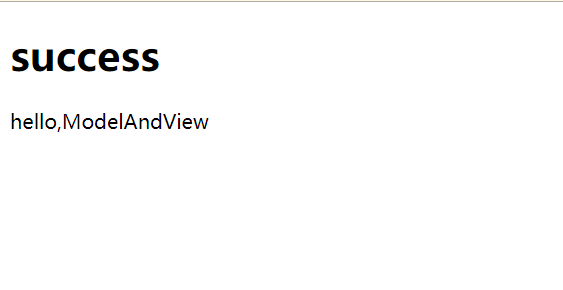
5.3、使用Model向request域对象共享数据
@RequestMapping("/testModel")
public String testModel(Model model){
model.addAttribute("testScope", "hello,Model");
return "success";
}
5.4、使用map向request域对象共享数据
@RequestMapping("/testMap")
public String testMap(Map<String, Object> map){
map.put("testScope", "hello,Map");
return "success";
}
5.5、使用ModelMap向request域对象共享数据
@RequestMapping("/testModelMap")
public String testModelMap(ModelMap modelMap){
modelMap.addAttribute("testScope", "hello,ModelMap");
return "success";
}
5.7、向session域共享数据
@RequestMapping("/testSession")
public String testSession(HttpSession session){
session.setAttribute("testSessionScope", "hello,session");
return "success";
}
5.8、向application域共享数据
介绍
@RequestMapping("/testApplication")
public String testApplication(HttpSession session){
ServletContext application = session.getServletContext();
application.setAttribute("testApplicationScope", "hello,application");
return "success";
}

服务器关闭不清空session
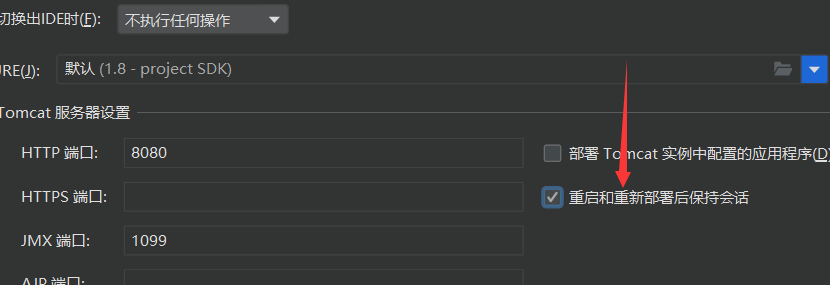
6、SpringMVC的视图
SpringMVC中的视图是View接口,视图的作用渲染数据,将模型Model中的数据展示给用户
SpringMVC视图的种类很多,默认有转发视图和重定向视图
当工程引入jstl的依赖,转发视图会自动转换为JstlView
若使用的视图技术为Thymeleaf,在SpringMVC的配置文件中配置了Thymeleaf的视图解析器,由此视图解析器解析之后所得到的是ThymeleafView
6.1、ThymeleafView
当控制器方法中所设置的视图名称没有任何前缀时,此时的视图名称会被SpringMVC配置文件中所配置的视图解析器解析,视图名称==拼接视图前缀和视图
后缀所得到的最终路径,会通过转发的方式==实现跳转
@RequestMapping("/testHello")
public String testHello(){
return "hello";
}

5.6、Model、ModelMap、Map的关系
Model、ModelMap、Map类型的参数其实本质上都是 BindingAwareModelMap 类型的
public interface Model{}
public class ModelMap extends LinkedHashMap<String, Object> {}
public class ExtendedModelMap extends ModelMap implements Model {}
public class BindingAwareModelMap extends ExtendedModelMap {}
6.2、转发视图
SpringMVC中默认的转发视图是InternalResourceView
SpringMVC中创建转发视图的情况:
当控制器方法中所设置的视图名称以"forward:"为前缀时,创建InternalResourceView视图,此时的视图名称不会被SpringMVC配置文件中所配置的视图解析器解析,而是会将前缀"forward:"去掉,剩余部分作为最终路径通过转发的方式实现跳转
例如"forward:/",“forward:/employee”
@RequestMapping("/test/view/forward")
public String testForward(){
return "forward:/test/model
";
}

转发的url并不会发生改变

[!note]
用的最多的是ThymeleafView,ThymeleafView会进行解析转发到的页面,要想看到ThymeleafView的语法被解析来进行页面渲染就必须使用ThymeleafView的转发方式
6.3、重定向视图
SpringMVC中默认的重定向视图是RedirectView
当控制器方法中所设置的视图名称以"redirect:"为前缀时,创建RedirectView视图,此时的视图名称不
会被SpringMVC配置文件中所配置的视图解析器解析,而是会将前缀"redirect:"去掉,剩余部分作为最终路径通过重定向的方式实现跳转
例如"redirect:/",“redirect:/employee”
<a th:href="@{/test/view/redict}" >测试重定向视图</a>
@RequestMapping("/test/view/redict")
public String testRedirectView(){
return "redirect:/test/model";
}

地址变了

注:
重定向视图在解析时,会先将redirect:前缀去掉,然后会判断剩余部分是否以/开头,若是则会自
动拼接上下文路径
一般执行成功的时候用重定向,失败的时候用转发
6.4、视图控制器view-controller
当控制器方法中,仅仅用来实现页面跳转,即只需要设置视图名称时,可以将处理器方法使用view-controller标签进行表示
<!--
path:设置处理的请求地址
view-name:设置请求地址所对应的视图名称
-->视图控制器:为当前的请求直接设置视图名称实现页面跳转-
<mvc:view-controller path="/testView" view-name="success"></mvc:view-controller>
注:
当SpringMVC中设置任何一个view-controller时==,其他控制器中的请求映射将全部失效,此时需要在SpringMVC的核心配置文件中设置开启mvc注解驱动的标签==:
<mvc:annotation-driven />
此时RequestMapping里面的请求和视图控制里面的请求都可以获取
7.1、RESTful简介
REST:Representational State Transfer,表现层资源状态转移。
①资源
资源是一种看待服务器的方式,即,将服务器看作是由很多离散的资源组成。每个资源是服务器上一个可命名的抽象概念。因为资源是一个抽象的概念,所以它不仅仅能代表服务器文件系统中的一个文件、数据库中的一张表等等具体的东西,可以将资源设计的要多抽象有多抽象,只要想象力允许而且客户端应用开发者能够理解。与面向对象设计类似,资源是以名词为核心来组织的,首先关注的是名词。一个资源可以由一个或多个URI来标识。URI既是资源的名称,也是资源在Web上的地址。对某个资源感兴趣的客户端应用,可以通过资源的URI与其进行交互。
②资源的表述
资源的表述是一段对于资源在某个特定时刻的状态的描述。可以在客户端-服务器端之间转移(交
换)。资源的表述可以有多种格式,例如HTML/XML/JSON/纯文本/图片/视频/音频等等。资源的表述格式可以通过协商机制来确定。请求-响应方向的表述通常使用不同的格式。
③状态转移
状态转移说的是:在客户端和服务器端之间转移(transfer)代表资源状态的表述。通过转移和操作资
源的表述,来间接实现操作资源的目的。
7.2、RESTful的实现
具体说,就是 HTTP 协议里面,四个表示操作方式的动词:GET、POST、PUT、DELETE。
它们分别对应四种基本操作:GET 用来获取资源,POST 用来新建资源,PUT 用来更新资源,DELETE
用来删除资源。
REST 风格提倡 URL 地址使用统一的风格设计,从前到后各个单词使用斜杠分开,不使用问号键值对方式携带请求参数,而是将要发送给服务器的数据作为 URL 地址的一部分,以保证整体风格的一致性。
| 操作 |
传统方式 |
REST风格 |
| 查询操作 |
getUserById?id=1 |
user/1–>get请求方式 |
| 保存操作 |
saveUser |
user–>post请求方式 |
| 删除操作 |
deleteUser?id=1 |
user/1–>delete请求方式 |
| 更新操作 |
updateUser |
user–>put请求方式 |
7.3、HiddenHttpMethodFilter
由于浏览器只支持发送get和post方式的请求,那么该如何发送put和delete请求呢?
SpringMVC 提供了 HiddenHttpMethodFilter 帮助我们将 POST 请求转换为 DELETE 或 PUT 请求
HiddenHttpMethodFilter 处理put和delete请求的条件:
a>当前请求的请求方式必须为post
b>当前请求必须传输请求参数_method
满足以上条件,HiddenHttpMethodFilter 过滤器就会将当前请求的请求方式转换为请求参数
_method的值,因此请求参数_method的值才是最终的请求方式
在web.xml中注册HiddenHttpMethodFilter
<filter>
<filter-name>HiddenHttpMethodFilter</filter-name>
<filter-class>org.springframework.web.filter.HiddenHttpMethodFilter</filterclass>
</filter>
<filter-mapping>
<filter-name>HiddenHttpMethodFilter</filter-name>
<url-pattern>/*</url-pattern>
</filter-mapping>
[!note]
注意:浏览器目前只能发送get和post请求
若要发送put和deLete请求,需要在web.xmL中配置一个过滤器iddenHttpMethodFilter配置了过滤器之后,发送的请求要满足两个条件,才能将请求方式转换为put或deLete1,当前请求必须为post
2,当前请求必须传输请求参数_method,_method的值才是最终的请求方式

注:
目前为止,SpringMVC中提供了两个过滤器:CharacterEncodingFilter和
HiddenHttpMethodFilter
在web.xml中注册时,必须先注册CharacterEncodingFilter,再注册HiddenHttpMethodFilter
原因:
- 在 CharacterEncodingFilter 中通过 request.setCharacterEncoding(encoding) 方法设置字
符集的
-
request.setCharacterEncoding(encoding) 方法要求前面不能有任何获取请求参数的操作
-
而 HiddenHttpMethodFilter 恰恰有一个获取请求方式的操作:
-
String paramValue = request.getParameter(this.methodParam);
8、RESTful案例
8.1、准备工作
和传统 CRUD 一样,实现对员工信息的增删改查。
package com.atguigu.mvc.bean;
public class Employee {
private Integer id;
private String lastName;
private String email;
//1 male, 0 female
private Integer gender;
public Integer getId() {
return id;
}
public void setId(Integer id) {
this.id = id;
}
public String getLastName() {
return lastName;
}
public void setLastName(String lastName) {
this.lastName = lastName;
}
public String getEmail() {
return email;
}
public void setEmail(String email) {
this.email = email;
}
public Integer getGender() {
return gender;
}
public void setGender(Integer gender) {
this.gender = gender;
}
public Employee(Integer id, String lastName, String email, Integergender) {
super();
this.id = id;
this.lastName = lastName;
this.email = email;
this.gender = gender;
}
public Employee() {
}
}
package com.atguigu.mvc.dao;
import java.util.Collection;
import java.util.HashMap;
import java.util.Map;
import com.atguigu.mvc.bean.Employee;
import org.springframework.stereotype.Repository;
@Repository
public class EmployeeDao {
private static Map<Integer, Employee> employees = null;
static{
employees = new HashMap<Integer, Employee>();
employees.put(1001, new Employee(1001, "E-AA", "aa@163.com", 1));
employees.put(1002, new Employee(1002, "E-BB", "bb@163.com", 1));
employees.put(1003, new Employee(1003, "E-CC", "cc@163.com", 0));
employees.put(1004, new Employee(1004, "E-DD", "dd@163.com", 0));
employees.put(1005, new Employee(1005, "E-EE", "ee@163.com", 1));
}
private static Integer initId = 1006;
public void save(Employee employee){
if(employee.getId() == null){
employee.setId(initId++);
}
employees.put(employee.getId(), employee);
}
public Collection<Employee> getAll(){
return employees.values();
}
public Employee get(Integer id){
return employees.get(id);
}
public void delete(Integer id){
employees.remove(id);
}
}
8.2、功能清单
| 功能 |
URL 地址
|
请求方式 |
| 访问首页√ |
/ |
GET |
| 查询全部数据√ |
/employee |
GET |
| 删除√ |
/employee/2 |
DELETE |
| 跳转到添加数据页面√ |
/toAdd |
GET |
| 执行保存√ |
/employee |
POST |
| 跳转到更新数据页面√ |
/employee/2 |
GET |
| 执行更新√ |
/employee |
PUT |
8.3、具体功能:访问首页
①配置view-controller
<mvc:view-controller path="/" view-name="index"/>
②创建页面
<!DOCTYPE html>
<html lang="en" xmlns:th="http://www.thymeleaf.org">
<head>
<meta charset="UTF-8" >
<title>Title</title>
</head>
<body>
<h1>首页</h1>
<a th:href="@{/employee}">访问员工信息</a>
</body>
</html>
8.4、具体功能:查询所有员工数据
①控制器方法
@Controller
public class EmployeeController {
@Autowired
private EmployeeDao employeeDao;
@RequestMapping(value = "/employee", method = RequestMethod.GET)
public String getAllEmployee(Model model){
//获取所有员工信息
Collection<Employee> all = employeeDao.getAll();
//将员工信息放在请求域中共享
model.addAttribute("allEmployee",all);
return "employee_list";
}
②创建employee_list.html
<!DOCTYPE html>
<html lang="en" xmlns:th="http://www.thymeleaf.org">
<head>
<meta charset="UTF-8">
<title>Employee Info</title>
<script type="text/javascript" th:src="@{/static/js/vue.js}"></script>
</head>
<body>
<table border="1" cellpadding="0" cellspacing="0" style="text-align:center;" id="dataTable">
<tr>
<th colspan="5">Employee Info</th>
</tr>
<tr>
<th>id</th>
<th>lastName</th>
<th>email</th>
<th>gender</th>
<th>options(<a th:href="@{/toAdd}">add</a>)</th>
</tr>
<tr th:each="employee : ${allEmployee}">
<td th:text="${employee.id}"></td>
<td th:text="${employee.lastName}"></td>
<td th:text="${employee.email}"></td>
<td th:text="${employee.gender}"></td>
<td>
<a class="deleteA" @click="deleteEmployee"
th:href="@{'/employee/'+${employee.id}}">delete</a>
<a th:href="@{'/employee/'+${employee.id}}">update</a>
</td>
</tr>
</table>
</body>
</html>

③处理静态资源
我们项目的web.xml是会继承Tomcat的web.xml,我们tomcat原本配置静态资源由一个专门的servlet处理,但是项目的Dispatcherservlet配置为对所有文件生效,但是它又处理不了静态资源,所以会导致css失效
<!--配置默认的servlet处理静态资源,
当前工程的web.xml配置的前端控制器pispatcherservlet的url -pattern是/
tomcat的web.xm儿配置的Defaultservlet的url-pattern也是/
此时,浏览器发送的请求会优先被DispatcherservLet进行处理,但是DispatcherservLet无法处理静态资源若配置了<mvc: default-servlet-handler />,此时浏览器发送的所有请求都会被Defaultservlet处理若配置了<mvc:default-servlet-handler />和<mvc : annotation-driven />
浏览器发送的请求会先被Dispatcherservlet处理,无法处理在交给Defaultservlet处理
-->
<mvc:default-servlet-handler />
<!--开启mvc注解驱动-->
<mvc:annotation-driven />
必须搭配annotation-driven使用,不然全部都会用默认的servlet来处理
8.5、具体功能:删除
[!important]
原本的删除是一个链接,但是我们需要用表达传输delete请求,这时我们就得用到vue来绑定事件,把链接绑定到表单的action里面,而表单提交delete请求需要配置[[springmvc#7.3、HiddenHttpMethodFilter]]
①创建处理delete请求方式的表单
<!-- 作用:通过超链接控制表单的提交,将post请求转换为delete请求 -->
<form id="delete_form" method="post">
<!-- HiddenHttpMethodFilter要求:必须传输_method请求参数,并且值为最终的请求方式 -->
<input type="hidden" name="_method" value="delete"/>
</form>
<div id="app">
<table border="1" cellpadding="0" cellspacing="0" style="text-align:center;" id="dataTable">
<tr> <th colspan="5">Employee Info</th>
</tr> <tr> <th>id</th>
<th>lastName</th>
<th>email</th>
<th>gender</th>
<th>options(<a th:href="@{/toAdd}">add</a>)</th>
</tr> <tr th:each="employee : ${allEmployee}">
<td th:text="${employee.id}"></td>
<td th:text="${employee.lastName}"></td>
<td th:text="${employee.email}"></td>
<td th:text="${employee.gender}"></td>
<td><a @click="deleteEmployee()" th:href="@{'/employee/'+${employee.id}}">delete</a>
<a th:href="@{'/employee/'+${employee.id}}">update</a>
</td>
</tr>
</table>
<form method="post">
<input type="hidden" name="_method" value="delete">
</form>
</div>
引入vue.js==,默认的servert需要设置才能使用静态资源==
<script type="text/javascript" th:src="@{/static/js/vue.js}"></script>
删除超链接
<a class="deleteA" @click="deleteEmployee"th:href="@{'/employee/'+${employee.id}}">delete</a>
通过vue处理点击事件
<script type="text/javascript">
var vue = new Vue({
el:"#dataTable",
methods:{
//event表示当前事件
deleteEmployee:function (event) {
//通过id获取表单标签
var delete_form = document.getElementById("delete_form");
//将触发事件的超链接的href属性为表单的action属性赋值
delete_form.action = event.target.href;
//提交表单
delete_form.submit();
//阻止超链接的默认跳转行为
event.preventDefault();
}
}
});
</script>
③控制器方法
请求方式为delete
@RequestMapping(value = "/employee/{id}", method = RequestMethod.DELETE)
public String deleteEmployee(@PathVariable("id") Integer id){
employeeDao.delete(id);
return "redirect:/employee";
}
8.6、具体功能:跳转到添加数据页面
①配置view-controller
<mvc:view-controller path="/toAdd" view-name="employee_add"></mvc:view-controller>
②创建employee_add.html
<!DOCTYPE html>
<html lang="en" xmlns:th="http://www.thymeleaf.org">
<head>
<meta charset="UTF-8">
<title>Add Employee</title>
</head>
<body>
<form th:action="@{/employee}" method="post">
lastName:<input type="text" name="lastName"><br>
email:<input type="text" name="email"><br>
gender:<input type="radio" name="gender" value="1">male
<input type="radio" name="gender" value="0">female<br>
<input type="submit" value="add"><br>
</form>
</body>
</html>
8.7、具体功能:执行保存
①控制器方法
@RequestMapping(value = "/employee", method = RequestMethod.POST)
public String addEmployee(Employee employee){
employeeDao.save(employee);
return "redirect:/employee";
}
8.8、具体功能:跳转到更新数据页面
①修改超链接
不拼接后面的就会当成路径来解析而不是一个表达式的值
<a th:href="@{'/employee/'+${employee.id}}">update</a>
②控制器方法
@RequestMapping(value = "/employee/{id}", method = RequestMethod.GET)
public String getEmployeeById(@PathVariable("id") Integer id, Model model){
Employee employee = employeeDao.get(id);
model.addAttribute("employee", employee);
return "employee_update";
}
③创建employee_update.html
<!DOCTYPE html>
<html lang="en" xmlns:th="http://www.thymeleaf.org">
<head>
<meta charset="UTF-8">
<title>Update Employee</title>
</head>
<body>
<form th:action="@{/employee}" method="post">
<input type="hidden" name="_method" value="put">
<input type="hidden" name="id" th:value="${employee.id}">
lastName:<input type="text" name="lastName" th:value="${employee.lastName}">
<br>
email:<input type="text" name="email" th:value="${employee.email}"><br>
<!--
th:field="${employee.gender}"可用于单选框或复选框的回显
若单选框的value和employee.gender的值一致,则添加checked="checked"属性
-->
gender:<input type="radio" name="gender" value="1"th:field="${employee.gender}">male
<input type="radio" name="gender" value="0"th:field="${employee.gender}">female<br>
<input type="submit" value="update"><br>
</form>
</body>
</html>
8.9、具体功能:执行更新
①控制器方法
@RequestMapping(value = "/employee", method = RequestMethod.PUT)
public String updateEmployee(Employee employee){
employeeDao.save(employee);
return "redirect:/employee";
}
9、SpringMVC处理ajax请求
回顾
<div id="app">
<h1>index.html</h1>
<input type="button" value="测试SpringMVC处理ajax" @click="testAjax()"><br>
<input type="button" value="使用@RequestBody注解处理json格式的请求参数" @click="testRequestBody()"><br>
<a th:href="@{/test/ResponseBody}">测试@ResponseBody注解响应浏览器数据</a><br>
<input type="button" value="使用@ResponseBody注解响应json格式的数据" @click="testResponseBody()"><br>
<a th:href="@{/test/down}">下载图片</a>
<form th:action="@{/test/up}" method="post" enctype="multipart/form-data">
头像:<input type="file" name="photo"><br>
<input type="submit" value="上传">
</form>
</div>
<script type="text/javascript" th:src="@{/js/vue.js}"></script>
<script type="text/javascript" th:src="@{/js/axios.min.js}"></script>
<script type="text/javascript">
/**
* axios({
url:"",//请求路径
method:"",//请求方式
//以name=value&name=value的方式发送的请求参数
//不管使用的请求方式是get或post,请求参数都会被拼接到请求地址后
//此种方式的请求参数可以通过request.getParameter()获取
params:{},
//以json格式发送的请求参数
//请求参数会被保存到请求报文的请求体传输到服务器
//此种方式的请求参数不可以通过request.getParameter()获取
data:{}
}).then(response=>{
console.log(response.data);
});
*/
var vue = new Vue({
el:"#app",
methods:{
testAjax(){
axios.post(
"/SpringMVC/test/ajax?id=1001",
{username:"admin",password:"123456"}
).then(response=>{
console.log(response.data);
});
},
testRequestBody(){
axios.post(
"/SpringMVC/test/RequestBody/json",
{username:"admin",password:"123456",age:23,gender:"男"}
).then(response=>{
console.log(response.data);
});
},
testResponseBody(){
axios.post("/SpringMVC/test/ResponseBody/json").then(response=>{
console.log(response.data);
});
}
}
});
</script>
data的数据会放在请求体中
[外链图片转存失败,源站可能有防盗链机制,建议将图片保存下来直接上传(img-uY1qWtSc-1686124821306)(null)]
在模型数据中我们经常创建一些json对象,json数组,将这些和页面中的表单进行双向绑定,表单中输入了数据后,data中设置的模型数据就可以获取到这些输入的数据

9.1、@RequestBody
@RequestBody可以获取请求体信息,使用@RequestBody注解标识控制器方法的形参,当前请求的请求体就会为当前注解所标识的形参赋值
<!--此时必须使用post请求方式,因为get请求没有请求体-->
<form th:action="@{/test/RequestBody}" method="post">
用户名:<input type="text" name="username"><br>
密码:<input type="password" name="password"><br>
<input type="submit">
</form>
@RequestMapping("/test/RequestBody")
public String testRequestBody(@RequestBody String requestBody){
System.out.println("requestBody:"+requestBody);
return "success";
}
输出结果:
requestBody:username=admin&password=123456
9.2、@RequestBody获取json格式的请求参数
在使用了axios发送ajax请求之后,浏览器发送到服务器的请求参数有两种格式:
1、name=value&name=value…,此时的请求参数可以通过request.getParameter()获取,对应
SpringMVC中,可以直接通过控制器方法的形参获取此类请求参数
2、{key:value,key:value,…},此时无法通过request.getParameter()获取,之前我们使用操作
json的相关jar包gson或jackson处理此类请求参数,可以将其转换为指定的实体类对象或map集
合。在SpringMVC中,直接使用@RequestBody注解标识控制器方法的形参即可将此类请求参数
转换为java对象
使用@RequestBody获取json格式的请求参数的条件:
1、导入jackson的依赖
<dependency>
<groupId>com.fasterxml.jackson.core</groupId>
<artifactId>jackson-databind</artifactId>
<version>2.12.1</version>
</dependency>
2、SpringMVC的配置文件中设置开启mvc的注解驱动
<!--开启mvc的注解驱动-->
<mvc:annotation-driven />
3、在控制器方法的形参位置,设置json格式的请求参数要转换成的java类型(实体类或map)的参
数,并使用@RequestBody注解标识
<input type="button" value="测试@RequestBody获取json格式的请求参数"@click="testRequestBody()"><br>
<script type="text/javascript" th:src="@{/js/vue.js}"></script>
<script type="text/javascript" th:src="@{/js/axios.min.js}"></script>
<script type="text/javascript">
var vue = new Vue({
el:"#app",
methods:{
testRequestBody(){
axios.post(
"/SpringMVC/test/RequestBody/json",
{username:"admin",password:"123456"}
).then(response=>{
console.log(response.data);
});
}
}
});
</script>
//将json格式的数据转换为map集合
@RequestMapping("/test/RequestBody/json")
public void testRequestBody(@RequestBody Map<String, Object> map,HttpServletResponse response) throws IOException {
System.out.println(map);
//{username=admin, password=123456}
response.getWriter().print("hello,axios");
}
//将json格式的数据转换为实体类对象
@RequestMapping("/test/RequestBody/json")
public void testRequestBody(@RequestBody User user, HttpServletResponseresponse) throws IOException {
System.out.println(user);
//User{id=null, username='admin', password='123456', age=null,gender='null'}
response.getWriter().print("hello,axios");
}
9.3、@ResponseBody
@ResponseBody用于标识一个控制器方法,可以将该方法的返回值直接作为响应报文的响应体响应到浏览器
@RequestMapping("/testResponseBody")
public String testResponseBody(){
//此时会跳转到逻辑视图success所对应的页面
return "success";
}
@RequestMapping("/testResponseBody")
@ResponseBody
public String testResponseBody(){
//此时响应浏览器数据success
return "success";
}
9.4、@ResponseBody响应浏览器json数据
服务器处理ajax请求之后,大多数情况都需要向浏览器响应一个java对象,此时必须将java对象转换为
json字符串才可以响应到浏览器,之前我们使用操作json数据的jar包gson或jackson将java对象转换为
json字符串。在SpringMVC中,我们可以直接使用@ResponseBody注解实现此功能
@ResponseBody响应浏览器json数据的条件:
1、导入jackson的依赖
<dependency>
<groupId>com.fasterxml.jackson.core</groupId>
<artifactId>jackson-databind</artifactId>
<version>2.12.1</version>
</dependency>
2、SpringMVC的配置文件中设置开启mvc的注解驱动
<!--开启mvc的注解驱动-->
<mvc:annotation-driven />
3、使用@ResponseBody注解标识控制器方法,在方法中,将需要转换为json字符串并响应到浏览器
的java对象作为控制器方法的返回值,此时SpringMVC就可以将此对象直接转换为json字符串并响应到浏览器
<input type="button" value="测试@ResponseBody响应浏览器json格式的数据"@click="testResponseBody()"><br>
<script type="text/javascript" th:src="@{/js/vue.js}"></script>
<script type="text/javascript" th:src="@{/js/axios.min.js}"></script>
<script type="text/javascript">
var vue = new Vue({
el:"#app",
methods:{
testResponseBody(){
axios.post("/SpringMVC/test/ResponseBody/json").then(response=>{
console.log(response.data);
});
}
}
});
</script>
//响应浏览器list集合
@RequestMapping("/test/ResponseBody/json")
@ResponseBody
public List<User> testResponseBody(){
User user1 = new User(1001,"admin1","123456",23,"男");
User user2 = new User(1002,"admin2","123456",23,"男");
User user3 = new User(1003,"admin3","123456",23,"男");
List<User> list = Arrays.asList(user1, user2, user3);
return list;
}
//响应浏览器map集合
@RequestMapping("/test/ResponseBody/json")
@ResponseBody
public Map<String, Object> testResponseBody(){
User user1 = new User(1001,"admin1","123456",23,"男");
User user2 = new User(1002,"admin2","123456",23,"男");
User user3 = new User(1003,"admin3","123456",23,"男");
Map<String, Object> map = new HashMap<>();
map.put("1001", user1);
map.put("1002", user2);
map.put("1003", user3);
return map;
}
//响应浏览器实体类对象
@RequestMapping("/test/ResponseBody/json")
@ResponseBody
public User testResponseBody(){
return user;
}

常用的Java对象转换为json的结果:
实体类–>json对象
map–>json对象
list–>json数组(方括号包裹的)
9.5、@RestController注解
@RestController注解是springMVC提供的一个复合注解,标识在控制器的类上,就相当于为类添加了
@Controller注解,并且为其中的每个方法添加了@ResponseBody注解
10、文件上传和下载
10.1、文件下载
ResponseEntity:可以作为控制器方法的返回值,表示响应到浏览器的完整的响感报文
ResponseEntity用于控制器方法的返回值类型,该控制器方法的返回值就是响应到浏览器的响应报文
使用ResponseEntity实现下载文件的功能
真实地址的样子

文件分隔符的表示File.separator

is.available()获取流的字节数
@RequestMapping("/testDown")
public ResponseEntity<byte[]> testResponseEntity(HttpSession session) throws
IOException {
//通过session获取ServletContext对象
ServletContext servletContext = session.getServletContext();
//获取服务器中文件的真实路径
String realPath = servletContext.getRealPath("/static/img/1.jpg");
//创建输入流
InputStream is = new FileInputStream(realPath);
//创建字节数组
byte[] bytes = new byte[is.available()];
//将流读到字节数组中
is.read(bytes);
//创建HttpHeaders对象设置响应头信息
MultiValueMap<String, String> headers = new HttpHeaders();
//Content-Disposition设置要下载方式
//attachment以附件的方式进行下载
//设置下载文件的名字
headers.add("Content-Disposition", "attachment;filename=1.jpg");
//设置响应状态码
HttpStatus statusCode = HttpStatus.OK;
//创建ResponseEntity对象
ResponseEntity<byte[]> responseEntity = new ResponseEntity<>(bytes, headers,statusCode);
//关闭输入流
is.close();
return responseEntity;
}
10.2、文件上传
文件上传要求form表单的请求方式必须为post,并且添加属性enctype="multipart/form-data"
SpringMVC中将上传的文件封装到MultipartFile对象中,通过此对象可以获取文件相关信息
上传步骤:
①添加依赖:
<!-- https://mvnrepository.com/artifact/commons-fileupload/commons-fileupload -->
<dependency>
<groupId>commons-fileupload</groupId>
<artifactId>commons-fileupload</artifactId>
<version>1.3.1</version>
</dependency>
②在SpringMVC的配置文件中添加配置:
<!--配置文件上传解析器 id必须配置为固定值,因为springmvc是靠id来获取这个解析器的-->
<!-- 单例的情况下,他的实例化过程是在获取ioc容器的时候执行-->
<bean id="multipartResolver"
class="org.springframework.web.multipart.commons.CommonsMultipartResolver">
</bean>
③控制器方法:
@RequestMapping("/testUp")
public String testUp(MultipartFile photo, HttpSession session) throws IOException {
//获取上传的文件的文件名
String fileName = photo.getOriginalFilename();
//处理文件重名问题
String hzName = fileName.substring(fileName.lastIndexOf("."));
fileName = UUID.randomUUID().toString() + hzName;
//获取服务器中photo目录的路径
ServletContext servletContext = session.getServletContext();
String photoPath = servletContext.getRealPath("photo");
File file = new File(photoPath);
if(!file.exists()){
file.mkdir();
}
String finalPath = photoPath + File.separator + fileName;
//实现上传功能
photo.transferTo(new File(finalPath));
return "success";
}
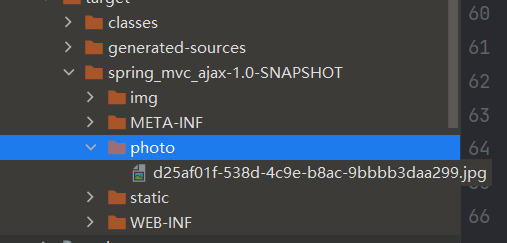
11、拦截器
过滤器是在浏览器和目标资源之间过滤

11.1、拦截器的配置
SpringMVC中的拦截器用于拦截控制器方法的执行
SpringMVC中的拦截器需要实现HandlerInterceptor
SpringMVC的拦截器必须在SpringMVC的配置文件中进行配置:
<mvc:interceptors>
<bean class="com.atguigu.interceptor.FirstInterceptor"></bean>
</mvc:interceptors>
<bean class="com.atguigu.interceptor.FirstInterceptor"></bean>
<!-- 以上两种配置方式都是对DispatcherServlet所处理的所有的请求进行拦截 -->
<mvc:interceptors>
<mvc:interceptor>
<!-- /*是处理一层目录的请求 /**是所有请求-->
<mvc:mapping path="/**"/>
<mvc:exclude-mapping path="/testRequestEntity"/>
<ref bean="firstInterceptor"></ref>
</mvc:interceptor>
</mvc:interceptors>
<!--
以上配置方式可以通过ref或bean标签设置拦截器,通过mvc:mapping设置需要拦截的请求,
通过mvc:exclude-mapping设置需要排除的请求,即不需要拦截的请求
-->
11.2、拦截器的三个抽象方法
这三个方法不管控制器方法有没有都会执行
SpringMVC中的拦截器有三个抽象方法:
preHandle:控制器方法执行之前执行preHandle(),其boolean类型的返回值表示是否拦截或放行,返回true为放行,即调用控制器方法;返回false表示拦截,即不调用控制器方法
postHandle:控制器方法执行之后执行postHandle()
afterCompletion:处理完视图和模型数据,渲染视图完毕之后执行afterCompletion()
11.3、多个拦截器的执行顺序

①若每个拦截器的preHandle()都返回true
此时多个拦截器的执行顺序和拦截器在SpringMVC的配置文件的配置顺序有关:preHandle()会按照配置的顺序执行,而postHandle()和afterCompletion()会按照配置的反序执行
②若某个拦截器的preHandle()返回了false
preHandle()返回false和它之前的拦截器的preHandle()都会执行,postHandle()都不执行,返回false的拦截器之前的拦截器的afterCompletion()会执行
12、异常处理器
控制器方法执行的过程中如果出现了异常,那么就可以通过springmvc给我们提供的一个接口来处理异常
12.1、基于配置的异常处理
SpringMVC提供了一个处理控制器方法执行过程中所出现的异常的接口:HandlerExceptionResolver
HandlerExceptionResolver接口的实现类有:DefaultHandlerExceptionResolver和
SimpleMappingExceptionResolver
SpringMVC提供了自定义的异常处理器SimpleMappingExceptionResolver,使用方式:
<bean
class="org.springframework.web.servlet.handler.SimpleMappingExceptionResolver">
<property name="exceptionMappings">
<props>
<!--
properties的键表示处理器方法执行过程中出现的异常
properties的值表示若出现指定异常时,设置一个新的视图名称,跳转到指定页面
-->
<prop key="java.lang.ArithmeticException">error</prop>
</props>
</property>
<!--
exceptionAttribute属性设置一个属性名,将出现的异常信息在请求域中进行共享
这里的ex就是异常信息在请求域中的属性名
-->
<property name="exceptionAttribute" value="ex"></property>
</bean>
出现了异常就会往我们设置好的页面去跳

获取请求域中共享的异常信息
<p th:text="${ex}"></p>
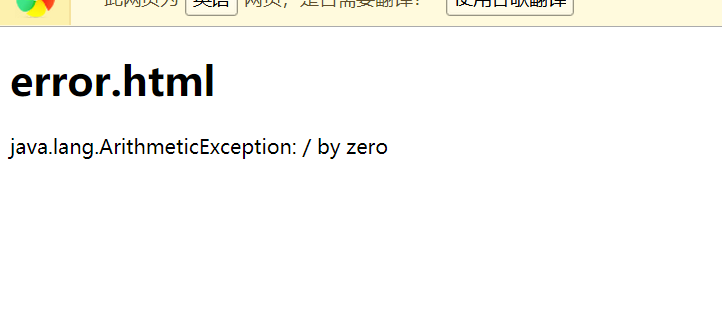
12.2、基于注解的异常处理
//@ControllerAdvice将当前类标识为异常处理的组件
@ControllerAdvice
public class ExceptionController {
//@ExceptionHandler用于设置所标识方法处理的异常
@ExceptionHandler(ArithmeticException.class)
//ex表示当前请求处理中出现的异常对象
public String handleArithmeticException(Exception ex, Model model){
model.addAttribute("ex", ex);
return "error";
}
}
13、注解配置SpringMVC
使用配置类和注解代替web.xml和SpringMVC配置文件的功能
13.1、创建初始化类,代替web.xml
在Servlet3.0环境中,容器会在类路径中查找实现javax.servlet.ServletContainerInitializer接口的类,如果找到的话就用它来配置Servlet容器。 Spring提供了这–…+个接口的实现,名为
SpringServletContainerInitializer,这个类反过来又会查找实现WebApplicationInitializer的类并将配置的任务交给它们来完成。Spring3.2引入了一个便利的WebApplicationInitializer基础实现,名为AbstractAnnotationConfigDispatcherServletInitializer,当我们的类扩展了
AbstractAnnotationConfigDispatcherServletInitializer并将其部署到Servlet3.0容器的时候,容器会自动发现它,并用它来配置Servlet上下文。用来代替web.xml
public class WebInit extends AbstractAnnotationConfigDispatcherServletInitializer {
//设置一个配置类代替spring配置文件
@Override
protected Class<?>[] getRootConfigClasses() {
return new Class[]{SpringConfig.class};
}
@Override
//设置一个配置类代替springmvc的配置文件
protected Class<?>[] getServletConfigClasses() {
return new Class[]{WebConfig.class};
}
@Override
//设置springMVC的前端控制器Dispatcherservlet的url-pattern
protected String[] getServletMappings() {
return new String[]{"/"};
}
@Override
//来设置当前的过滤器
protected Filter[] getServletFilters() {
//创建编码过滤器
CharacterEncodingFilter encodingFilter = new CharacterEncodingFilter();
encodingFilter.setEncoding("UTF-8");
encodingFilter.setForceRequestEncoding(true);
//创建处理请求方式的过滤器
HiddenHttpMethodFilter hiddenHttpMethodFilter = new HiddenHttpMethodFilter();
return new Filter[]{encodingFilter, hiddenHttpMethodFilter};
}
}
13.2、创建SpringConfig配置类,代替spring的配置文件
//@Configuration将当前类表示为配置类
@Configuration
public class SpringConfig {
//ssm整合之后,spring的配置信息写在此类中
}
13.3、创建WebConfig配置类,代替SpringMVC的配置文件
//代替springmvc的配置文件
@Configuration
//扫描主件
@ComponentScan("com.atguigu.controller")
//开启注解驱动
@EnableWebMvc
public class WebConfig implements WebMvcConfigurer {
//使用默认的servlet处理静态资源
@Override
public void configureDefaultServletHandling(DefaultServletHandlerConfigurer configurer) {
configurer.enable();
}
//配置文件上传解析器,@Bean注解可以将标识的方法的返回值作为bean进行管理,bean的id为方法的方法名
@Bean
public CommonsMultipartResolver multipartResolver(){
return new CommonsMultipartResolver();
}
//配置拦截器
@Override
public void addInterceptors(InterceptorRegistry registry) {
FirstInterceptor firstInterceptor = new FirstInterceptor();
registry.addInterceptor(firstInterceptor).addPathPatterns("/**");
}
//配置视图控制
@Override
public void addViewControllers(ViewControllerRegistry registry) {
registry.addViewController("/").setViewName("index");
}
//配置异常映射
@Override
public void configureHandlerExceptionResolvers(List<HandlerExceptionResolver> resolvers) {
SimpleMappingExceptionResolver exceptionResolver = new SimpleMappingExceptionResolver();
Properties prop = new Properties();
prop.setProperty("java.lang.ArithmeticException", "error");
//设置异常映射
exceptionResolver.setExceptionMappings(prop);
//设置共享异常信息的键
exceptionResolver.setExceptionAttribute("ex");
resolvers.add(exceptionResolver);
}
//配置生成模板解析器
@Bean
public ITemplateResolver templateResolver() {
WebApplicationContext webApplicationContext = ContextLoader.getCurrentWebApplicationContext();
// ServletContextTemplateResolver需要一个ServletContext作为构造参数,可通过WebApplicationContext 的方法获得
ServletContextTemplateResolver templateResolver = new
ServletContextTemplateResolver(webApplicationContext.getServletContext());
templateResolver.setPrefix("/WEB-INF/templates/");
templateResolver.setSuffix(".html");
templateResolver.setCharacterEncoding("UTF-8");
templateResolver.setTemplateMode(TemplateMode.HTML);
return templateResolver;
}
//生成模板引擎并为模板引擎注入模板解析器(保证参数名和提供这个参数的方法名一致即可)
@Bean
public SpringTemplateEngine templateEngine(ITemplateResolver templateResolver) {
SpringTemplateEngine templateEngine = new SpringTemplateEngine();
templateEngine.setTemplateResolver(templateResolver);
return templateEngine;
}
//生成视图解析器并未解析器注入模板引擎
@Bean
public ViewResolver viewResolver(SpringTemplateEngine templateEngine) {
ThymeleafViewResolver viewResolver = new ThymeleafViewResolver();
viewResolver.setCharacterEncoding("UTF-8");
viewResolver.setTemplateEngine(templateEngine);
return viewResolver;
}
}
13.4、测试功能
@RequestMapping("/")
public String index(){
return "index";
}
14、SpringMVC执行流程
14.1、SpringMVC常用组件
- DispatcherServlet:前端控制器,不需要工程师开发,由框架提供
作用:统一处理请求和响应,整个流程控制的中心,由它调用其它组件处理用户的请求
- HandlerMapping:处理器映射器,不需要工程师开发,由框架提供
作用:根据请求的url、method等信息查找Handler,即控制器方法(通过这个实现把请求匹配控制器方法)
- Handler:处理器,需要工程师开发(就是Controller)
作用:在DispatcherServlet的控制下Handler对具体的用户请求进行处理
- HandlerAdapter:处理器适配器,不需要工程师开发,由框架提供
作用:(通过HandlerMapping匹配控制器方法)通过HandlerAdapter对处理器(控制器方法)进行执行

- ViewResolver:视图解析器,不需要工程师开发,由框架提供
作用:进行视图解析,得到相应的视图,例如:ThymeleafView、InternalResourceView、
RedirectView
作用:将模型数据通过页面展示给用户
14.2、DispatcherServlet初始化过程
DispatcherServlet 本质上是一个 Servlet,所以天然的遵循 Servlet 的生命周期。所以宏观上是 Servlet生命周期来进行调度。
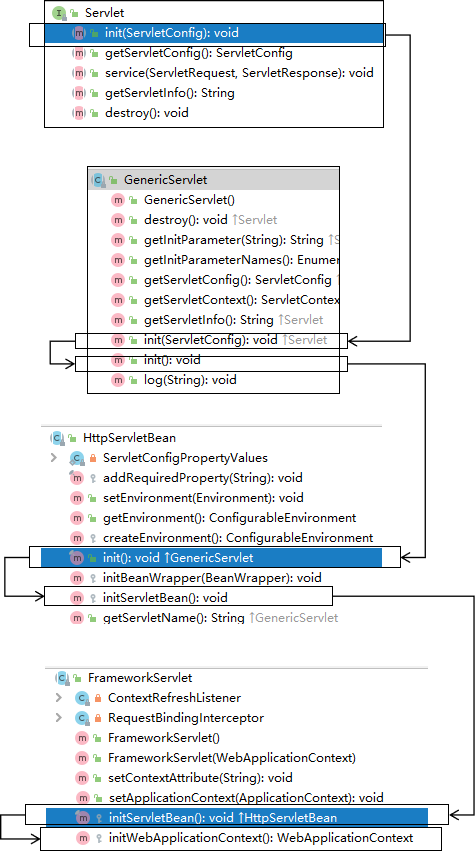
①初始化WebApplicationContext
所在类:org.springframework.web.servlet.FrameworkServlet
protected WebApplicationContext initWebApplicationContext() {
WebApplicationContext rootContext = WebApplicationContextUtils.getWebApplicationContext(getServletContext());
WebApplicationContext wac = null;
if (this.webApplicationContext != null) {
// A context instance was injected at construction time -> use it
wac = this.webApplicationContext;
if (wac instanceof ConfigurableWebApplicationContext) {
ConfigurableWebApplicationContext cwac =(ConfigurableWebApplicationContext) wac;
if (!cwac.isActive()) {
// The context has not yet been refreshed -> provide services such as
// setting the parent context, setting the application context id, etc
if (cwac.getParent() == null) {
// The context instance was injected without an explicit parent -> set
// the root application context (if any; may be null) as the parent
cwac.setParent(rootContext);
}
configureAndRefreshWebApplicationContext(cwac);
}
}
}
if (wac == null) {
// No context instance was injected at construction time -> see if one
// has been registered in the servlet context. If one exists, it is assumed
// that the parent context (if any) has already been set and that the
// user has performed any initialization such as setting the context id
wac = findWebApplicationContext();
}
if (wac == null) {
// No context instance is defined for this servlet -> create a local one
// 创建WebApplicationContext
wac = createWebApplicationContext(rootContext);
}
if (!this.refreshEventReceived) {
// Either the context is not a ConfigurableApplicationContext with refresh
// support or the context injected at construction time had already been
// refreshed -> trigger initial onRefresh manually here.
synchronized (this.onRefreshMonitor) {
// 刷新WebApplicationContext
onRefresh(wac);
}
}
if (this.publishContext) {
// Publish the context as a servlet context attribute.
// 将IOC容器在应用域共享
String attrName = getServletContextAttributeName();
getServletContext().setAttribute(attrName, wac);
}
return wac;
}
②创建WebApplicationContext
所在类:org.springframework.web.servlet.FrameworkServlet
protected WebApplicationContext createWebApplicationContext(@Nullable ApplicationContext parent) {
Class<?> contextClass = getContextClass();
if (!ConfigurableWebApplicationContext.class.isAssignableFrom(contextClass))
{
throw new ApplicationContextException("Fatal initialization error in servlet with name '" +getServletName() +
"': custom WebApplicationContext class [" + contextClass.getName() +
"] is not of type ConfigurableWebApplicationContext");
}
// 通过反射创建 IOC 容器对象
ConfigurableWebApplicationContext wac = (ConfigurableWebApplicationContext)BeanUtils.instantiateClass(contextClass);
wac.setEnvironment(getEnvironment());
// 设置父容器
wac.setParent(parent);
String configLocation = getContextConfigLocation();
if (configLocation != null) {
wac.setConfigLocation(configLocation);
}
configureAndRefreshWebApplicationContext(wac);
return wac;
}
③DispatcherServlet初始化策略
FrameworkServlet创建WebApplicationContext后,刷新容器,调用onRefresh(wac),此方法在
DispatcherServlet中进行了重写,调用了initStrategies(context)方法,初始化策略,即初始化
DispatcherServlet的各个组件
所在类:org.springframework.web.servlet.DispatcherServlet
protected void initStrategies(ApplicationContext context) {
initMultipartResolver(context);
initLocaleResolver(context);
initThemeResolver(context);
initHandlerMappings(context);
initHandlerAdapters(context);
initHandlerExceptionResolvers(context);
initRequestToViewNameTranslator(context);
initViewResolvers(context);
initFlashMapManager(context);
}
14.3、DispatcherServlet调用组件处理请求
①processRequest()
FrameworkServlet重写HttpServlet中的service()和doXxx(),这些方法中调用了
processRequest(request, response)
所在类:org.springframework.web.servlet.FrameworkServlet
protected final void processRequest(HttpServletRequest request,HttpServletResponse response)throws ServletException, IOException
{
long startTime = System.currentTimeMillis();
Throwable failureCause = null;
LocaleContext previousLocaleContext = LocaleContextHolder.getLocaleContext();
LocaleContext localeContext = buildLocaleContext(request);
RequestAttributes previousAttributes = RequestContextHolder.getRequestAttributes();
ServletRequestAttributes requestAttributes = buildRequestAttributes(request,response, previousAttributes);
WebAsyncManager asyncManager = WebAsyncUtils.getAsyncManager(request);
asyncManager.registerCallableInterceptor(FrameworkServlet.class.getName(),new RequestBindingInterceptor());
initContextHolders(request, localeContext, requestAttributes);
try {
// 执行服务,doService()是一个抽象方法,在DispatcherServlet中进行了重写
doService(request, response);
}
catch (ServletException | IOException ex) {
failureCause = ex;
throw ex;
}
catch (Throwable ex) {
failureCause = ex;
throw new NestedServletException("Request processing failed", ex);
}
finally {
resetContextHolders(request, previousLocaleContext, previousAttributes);
if (requestAttributes != null) {
requestAttributes.requestCompleted();
}
logResult(request, response, failureCause, asyncManager);
publishRequestHandledEvent(request, response, startTime, failureCause);
}
}
②doService()
所在类:org.springframework.web.servlet.DispatcherServlet
@Override
protected void doService(HttpServletRequest request, HttpServletResponse response) throws Exception {
logRequest(request);
// Keep a snapshot of the request attributes in case of an include,
// to be able to restore the original attributes after the include.
Map<String, Object> attributesSnapshot = null;
if (WebUtils.isIncludeRequest(request)) {
attributesSnapshot = new HashMap<>();
Enumeration<?> attrNames = request.getAttributeNames();
while (attrNames.hasMoreElements()) {
String attrName = (String) attrNames.nextElement();
if (this.cleanupAfterInclude || attrName.startsWith(DEFAULT_STRATEGIES_PREFIX)) {
attributesSnapshot.put(attrName,request.getAttribute(attrName));
}
}
}
// Make framework objects available to handlers and view objects.
request.setAttribute(WEB_APPLICATION_CONTEXT_ATTRIBUTE,getWebApplicationContext());
request.setAttribute(LOCALE_RESOLVER_ATTRIBUTE, this.localeResolver);
request.setAttribute(THEME_RESOLVER_ATTRIBUTE, this.themeResolver);
request.setAttribute(THEME_SOURCE_ATTRIBUTE, getThemeSource());
if (this.flashMapManager != null) {
FlashMap inputFlashMap = this.flashMapManager.retrieveAndUpdate(request,response);
if (inputFlashMap != null) {
request.setAttribute(INPUT_FLASH_MAP_ATTRIBUTE,Collections.unmodifiableMap(inputFlashMap));
}
request.setAttribute(OUTPUT_FLASH_MAP_ATTRIBUTE, new FlashMap());
request.setAttribute(FLASH_MAP_MANAGER_ATTRIBUTE, this.flashMapManager);
}
RequestPath requestPath = null;
if (this.parseRequestPath && !ServletRequestPathUtils.hasParsedRequestPath(request)) {
requestPath = ServletRequestPathUtils.parseAndCache(request);
}
try {
// 处理请求和响应
doDispatch(request, response);
}
finally {
if
(!WebAsyncUtils.getAsyncManager(request).isConcurrentHandlingStarted()) {
// Restore the original attribute snapshot, in case of an include.
if (attributesSnapshot != null) {
restoreAttributesAfterInclude(request, attributesSnapshot);
}
}
if (requestPath != null) {
ServletRequestPathUtils.clearParsedRequestPath(request);
}
}
}
③doDispatch()
所在类:org.springframework.web.servlet.DispatcherServlet
protected void doDispatch(HttpServletRequest request, HttpServletResponse response) throws Exception {
HttpServletRequest processedRequest = request;
HandlerExecutionChain mappedHandler = null;
boolean multipartRequestParsed = false;
WebAsyncManager asyncManager = WebAsyncUtils.getAsyncManager(request);
try {
ModelAndView mv = null;
Exception dispatchException = null;
try {
processedRequest = checkMultipart(request);
multipartRequestParsed = (processedRequest != request);
// Determine handler for the current request.
/*
mappedHandler:调用链
包含handler、interceptorList、interceptorIndex
handler:浏览器发送的请求所匹配的控制器方法
interceptorList:处理控制器方法的所有拦截器集合
interceptorIndex:拦截器索引,控制拦截器afterCompletion()的执行
*/
mappedHandler = getHandler(processedRequest);
if (mappedHandler == null) {
noHandlerFound(processedRequest, response);
return;
}
// Determine handler adapter for the current request.
// 通过控制器方法创建相应的处理器适配器,调用所对应的控制器方法
HandlerAdapter ha = getHandlerAdapter(mappedHandler.getHandler());
// Process last-modified header, if supported by the handler.
String method = request.getMethod();
boolean isGet = "GET".equals(method);
if (isGet || "HEAD".equals(method)) {
long lastModified = ha.getLastModified(request,mappedHandler.getHandler());
if (new ServletWebRequest(request,response).checkNotModified(lastModified) && isGet) {
return;
}
}
// 调用拦截器的preHandle()
if (!mappedHandler.applyPreHandle(processedRequest, response)) {
return;
}
// Actually invoke the handler.
// 由处理器适配器调用具体的控制器方法,最终获得ModelAndView对象
mv = ha.handle(processedRequest, response,mappedHandler.getHandler());
if (asyncManager.isConcurrentHandlingStarted()) {
return;
}
applyDefaultViewName(processedRequest, mv);
// 调用拦截器的postHandle()
mappedHandler.applyPostHandle(processedRequest, response, mv);
}
catch (Exception ex) {
dispatchException = ex;
}
catch (Throwable err) {
// As of 4.3, we're processing Errors thrown from handler methods as well,
// making them available for @ExceptionHandler methods and otherscenarios.
dispatchException = new NestedServletException("Handler dispatchfailed", err);
}
// 后续处理:处理模型数据和渲染视图
processDispatchResult(processedRequest, response, mappedHandler, mv,dispatchException);
}
catch (Exception ex) {
triggerAfterCompletion(processedRequest, response, mappedHandler, ex);
}
catch (Throwable err) {
triggerAfterCompletion(processedRequest, response, mappedHandler,new NestedServletException("Handler processingfailed",
err));
}
finally {
if (asyncManager.isConcurrentHandlingStarted()) {
// Instead of postHandle and afterCompletion
if (mappedHandler != null) {
mappedHandler.applyAfterConcurrentHandlingStarted(processedRequest, response);
}
}
else {
// Clean up any resources used by a multipart request.
if (multipartRequestParsed) {
cleanupMultipart(processedRequest);
}
}
}
}
④processDispatchResult()
private void processDispatchResult(HttpServletRequest request,HttpServletResponse response,@Nullable HandlerExecutionChain
mappedHandler, @Nullable ModelAndView mv,@Nullable Exception exception) throws Exception {
boolean errorView = false;
if (exception != null) {
if (exception instanceof ModelAndViewDefiningException) {
logger.debug("ModelAndViewDefiningException encountered",exception);
mv = ((ModelAndViewDefiningException) exception).getModelAndView();
}
else {
Object handler = (mappedHandler != null ? mappedHandler.getHandler(): null);
mv = processHandlerException(request, response, handler, exception);
errorView = (mv != null);
}
}
// Did the handler return a view to render?
if (mv != null && !mv.wasCleared()) {
// 处理模型数据和渲染视图
render(mv, request, response);
if (errorView) {
WebUtils.clearErrorRequestAttributes(request);
}
}
else {
if (logger.isTraceEnabled()) {
logger.trace("No view rendering, null ModelAndView returned.");
}
}
if (WebAsyncUtils.getAsyncManager(request).isConcurrentHandlingStarted()) {
// Concurrent handling started during a forward
return;
}
if (mappedHandler != null) {
// Exception (if any) is already handled..
// 调用拦截器的afterCompletion()
mappedHandler.triggerAfterCompletion(request, response, null);
}
}
14.4、SpringMVC的执行流程
\1) 用户向服务器发送请求,请求被SpringMVC 前端控制器 DispatcherServlet捕获。
\2) DispatcherServlet对请求URL进行解析,得到请求资源标识符(URI),判断请求URI对应的映射:
a) 不存在
i. 再判断是否配置了mvc:default-servlet-handler
ii. 如果没配置,则控制台报映射查找不到,客户端展示404错误

[外链图片转存失败,源站可能有防盗链机制,建议将图片保存下来直接上传(img-bScng8YE-1686124822443)(null)]
iii. 如果有配置,则访问目标资源(一般为静态资源,如:JS,CSS,HTML),找不到客户端也会展示404
错误


b) 存在则执行下面的流程
\3) 根据该URI,调用HandlerMapping获得该Handler配置的所有相关的对象(包括Handler对象以及
Handler对象对应的拦截器),最后以HandlerExecutionChain执行链对象的形式返回。
\4) DispatcherServlet 根据获得的Handler,选择一个合适的HandlerAdapter。
\5) 如果成功获得HandlerAdapter,此时将开始执行拦截器的preHandler(…)方法【正向】
\6) 提取Request中的模型数据,填充Handler入参,开始执行Handler(Controller)方法,处理请求。
在填充Handler的入参过程中,根据你的配置,Spring将帮你做一些额外的工作:
a) HttpMessageConveter: 将请求消息(如Json、xml等数据)转换成一个对象,将对象转换为指定
的响应信息
b) 数据转换:对请求消息进行数据转换。如String转换成Integer、Double等
c) 数据格式化:对请求消息进行数据格式化。 如将字符串转换成格式化数字或格式化日期等
d) 数据验证: 验证数据的有效性(长度、格式等),验证结果存储到BindingResult或Error中
\7) Handler执行完成后,向DispatcherServlet 返回一个ModelAndView对象。
\8) 此时将开始执行拦截器的postHandle(…)方法【逆向】。
\9) 根据返回的ModelAndView(此时会判断是否存在异常:如果存在异常,则执行
HandlerExceptionResolver进行异常处理)选择一个适合的ViewResolver进行视图解析,根据Model
和View,来渲染视图。
\10) 渲染视图完毕执行拦截器的afterCompletion(…)方法【逆向】。
\11) 将渲染结果返回给客户端。
15 . 监听器
使用原因
执行顺序:监听器,控制器,Servlet初始化,spring初始化要放在Servlet前面,这样保证在获取springmvc的ioc容器的时候,spring的ioc容器是创建好的,不在过滤器是因为:就好比在过滤器里放一段不需要过滤的代码,不太好

① ContextLoaderListener
Spring提供了监听器ContextLoaderListener,实现ServletContextListener接口,可监听
ServletContext的状态,在web服务器的启动,读取Spring的配置文件,创建Spring的IOC容器。web
应用中必须在web.xml中配置
<listener>
<!--
配置Spring的监听器,在服务器启动时加载Spring的配置文件
Spring配置文件默认位置和名称:/WEB-INF/applicationContext.xml
可通过上下文参数自定义Spring配置文件的位置和名称
-->
<listener-class>org.springframework.web.context.ContextLoaderListener</listener-class>
</listener>
<!--自定义Spring配置文件的位置和名称-->
<context-param>
<param-name>contextConfigLocation</param-name>
<param-”value>classpath:spring.xml</param-value>
</context-param>